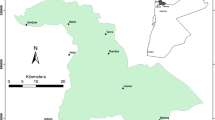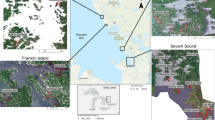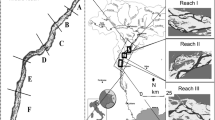Abstract
A vegetation mapping system for change detection was tested at the Havasu National Wildlife Refuge (HNWR) on the Lower Colorado River. A low-cost, aerial photomosaic of the 4200 ha, study area was constructed utilizing an automated digital camera system, supplemented with oblique photographs to aid in determining species composition and plant heights. Ground-truth plots showed high accuracy in distinguishing native cottonwood (Populus fremontii) and willow (Salix gooddingii) trees from other vegetation on aerial photos. Marsh vegetation (mainly cattails, Typha domengensis) was also easily identified. However, shrubby terrestrial vegetation, consisting of saltcedar (Tamarix ramosissima), arrowweed (Pluchea sericea), and mesquite trees (Prosopis spp.), could not be accurately distinguished from each other and were combined into a single shrub layer on the final vegetation map. The final map took the form of a base, shrub and marsh layer, which was displayed as a Normalized Difference Vegetation Index map from a Landsat Enhanced Thematic Mapper (ETM+) image to show vegetation intensity. Native willow and cottonwood trees were digitized manually on the photomosaic and overlain on the shrub layer in a GIS. By contrast to present, qualitative mapping systems used on the Lower Colorado River, this mapping system provides quantitative information that can be used for accurate change detection. However, better methods to distinguish between saltcedar, mesquite, and arrowweed are needed to map the shrub layer.
Similar content being viewed by others
References
Ahlbrandt, R.: 1999, Lower Colorado River Natural Vegetation, 1997, Needles Quadrangle, Bureau of Reclamation, Boulder City, Nevada.
Anderson, B. and Ohmart, R.: 1976, Vegetation type maps of the Lower Colorado River from Davis Dam to the Southerly International Boundary, Bureau of Reclamation, Boulder City, Nevada.
Anderson, B. and Ohmart, R.: 1985, ‘Habitat use by clapper rails in the Lower Colorado River Valley’, Condor 87, 116–126.
Briggs, M.: 1996, Riparian Recovery in Arid Lands, Strategies and References, University of Arizona Press, Tucson.
Busch, D. E. and Smith, S. D.: 1995, ‘Mechanisms associated with decline of woody species in riparian ecosystems of the southwestern US’, Ecolog. Monogr. 65, 347–370.
CH2MHILL: 1999, Lower Colorado River 1997 Vegetation Mapping and GIS Development, U.S. Bureau of Reclamation, Boulder City, Nevada.
Dahm, C., Cleverly, J. Coonrod, J. et~al.: 2002, ‘Evapotranspiration at the land/water interface in a semi-arid drainage basin’, Freshw. Biol. 47, 831–843.
Dean, C., Warner, T. and McGraw, J.: 2000, ‘Suitability of the DCS460c colour digital camera for quantitative remote sensing analysis of vegetation’, ISPRS J. Photogramm. Remote Sens. 55, 105–118.
Doren, R., Rutchey, K. and Welsh, R.: 1999, ‘The Everglades: A perspective on the requirements and applications for vegetation map and database products’, Photogramm. Eng. Remote Sens. 65, 155–161.
Dynesium, M. and Nilsson, C.: 1994, ‘Fragmentation and flow regulation of river systems in the northern 3rd of the world’, Science 266, 753–762.
Gould, W.: 2000, ‘Remote sensing of vegetation, plant species richness, and regional biodiversity hotspots’, Ecol. Appl. 10, 1861–1870.
Guay, B.: 2001, Preliminary Hydrologic Investigations of Topock Marsh, Arizona, Dissertation to University of Arizona, Tucson, AZ.
Huete, A., Didan, K., Miura, T., Rodreguez, E., Gao, X. and Ferreira, L.: 2002, ‘Overview of the radiometric and biophysical performance of the MODIS vegetation indices’, Remote Sens. Environ. 83, 195–213.
Lu, D., Mausel, P. and Moran, E.: 2004, ‘Change detection techniques’, Int. J. Remote Sens. 25, 2365–2407.
Muller, E.: 1997, Mapping riparian vegetation along rivers: Old concepts and new methods. Aquatic Bot. 58, 411–437.
Nagler, P., Glenn, E., Thompson, T. and Huete, A.: 2004. ‘Relationships between leaf area index, normalized difference vegetation index and canopy characteristics of riparian plants on the Lower Colorado River’, Agric. Forest Meteorol. 125, 1–17.
Nagler, P., Cleverly, J., Lampkin, D., Glenn, E. and Huete, A.: 2005, Predicting Riparian Evapotranspiration MODIS Vegetation Indices and Meteorological Data, Remote Sensing Environ. 94, 17–30.
Ohmart, R., Anderson, B. and Hunter, W.: 1988, ‘Ecology of the Lower Colorado River from Davis Dam to the Mexico-United States Boundary: A community profile, National Technical Information Service, Alexandria, Virginia, U.S.A.
Stromberg, J.: 2001, ‘Restoration of riparian vegetation in the south-western United States: Importance of flow regimes and fluvial dynamism’, J. Arid Environ. 49, 17–34.
U.S. Bureau of Reclamation: 1996, Description and Assessment of Operations, Maintenance, and Sensitive Species of the Lower Colorado River, U.S. Bureau of Reclamation, Boulder City, Nevada.
Watts, J.: 2000, San Pedro Vegetation Map, U.S. Army Topographic Engineering Center, Alexandria, VA.
Weber, R. and Dunno, G.: 2001, ‘Riparian vegetation mapping and image processing techniques, Hopi Indian Reservation, AZ’, Photogramm. Eng. Remote Sens. 67, 179–186.
Weiers, R.: 1998, Introduction to Business Statistics, 3rd edn. Duxbury Press, Pacific Grove, CA.
Witte, J.: 2002, ‘The descriptive capacity of ecological plant species groups’, Plant Ecol. 162, 199–213.
Author information
Authors and Affiliations
Corresponding author
Rights and permissions
About this article
Cite this article
Nagler, P., Glenn, E.P., Hursh, K. et al. Vegetation Mapping for Change Detection on an Arid-Zone River. Environ Monit Assess 109, 255–274 (2005). https://doi.org/10.1007/s10661-005-6285-y
Received:
Accepted:
Issue Date:
DOI: https://doi.org/10.1007/s10661-005-6285-y




